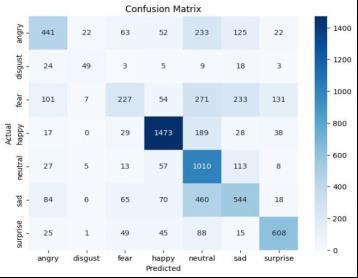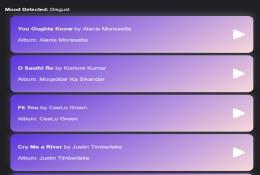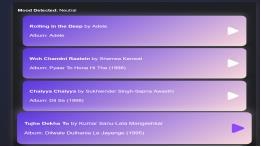
International Research Journal of Engineering and Technology (IRJET) e-ISSN:2395-0056
Volume: 12 Issue: 02 | Feb 2025 www.irjet.net p-ISSN:2395-0072


International Research Journal of Engineering and Technology (IRJET) e-ISSN:2395-0056
Volume: 12 Issue: 02 | Feb 2025 www.irjet.net p-ISSN:2395-0072
Rimsy Dua1, Kunvar Bir Pratap Singh2, Abhishek Gupta3
1Assitant Professor, Thakur College of Science and Commerce, Maharashtra, India 2,3 Bsc-IT UG, Thakur College of Science and Commerce, Maharashtra, India
Abstract - Users feel more satisfied with music recommendation systems because the systems tailor their features to personal tastes which affect howusersemotionally respond to music. Music recommendationsystemsinusefailto track user emotional states because they operate using collaborative filtering and user preference and listening records alone. Deep learning served as the technology that made possible the development of emotion-targeted music recommendations through artificial intelligence. The current technological advances permit facial recognition systems to monitor human emotionalresponsesthusenablingautomated music selection for users. The Convolutional Neural Network analyzes recorded facial expressions and identifies emotions between Happy and Sad as well as Angry through Neutral states to ensure content-based filtering obtainssuitable music outputs. A CNN model reaches higher accuracy once trained with FER2013 and CK+ dataset resources. Facial recognition features in the system are enabled through OpenCV backend operations which also run Python Flask and HTML CSS and JavaScript interfacessimultaneously.Thesystemimplementsa built-in chatbot functionality which lets users convey their emotional states through emojis for system input selection. User actions are recorded by administrator dashboards to obtain ongoing feedbackthathelpssystemdevelopersdiscover user emotions during system performance improvement efforts. System-based emotion detection happens in real-time leading to satisfied users and providing groundwork for AIbased entertainment system development.
Key Words: Facial Recognition, Emotion Detection, Artificial Intelligence, Deep Learning, CNN, OpenCV, Content-Based Filtering and Python Flask, Chatbot Interaction and Emotionally Intelligent Applications.
Emotionally healthy individuals create feelings as psychological elements which influence brain reactions whilestrengtheningmotivationalstrength.Musicalhuman toolsprovidekeyelements whichallowpeopleto express themselvesandobtainhealingpowerswhileimprovingtheir performanceatwork.Userprofilesconnectwithpreferred styles and previous listened music through automated recommendation generators to select the current music.Existingrecommendationplatformsfailtounderstand user emotions so they produce inadequate music suggestions.
Theanalysisofemotionalstatesrequiresfacialrecognition technology because face expressions display human emotions.Themarketsawthearrivalofartificialintelligence (AI)anddeeplearningtechnologieswhichdevelopedfacial emotionrecognition2013(FER)technologytoenhanceuser interactionsinallindustrieswithastrongimpactonmusic recommendations systems. The automatic music recommendationsystemreceivesuseremotionalstatesby using facial recognition software which it uses to create recommendationsbasedonreceivedinformation.
Before the system can detect emotions Happy to Sad it requiresprocessingwebcaminputusingCNNbutthesystem also includes detection of Angry to Surprised emotions as well as Disgusted Fearful and Neutral expressions. User songs become organized into frameworks within the database through emotional recognition which drives the recommendationprocess.Thesystemprovidestime-based songsuggestionsbasedonuseremotionsusingitsautomatic recommendationfunction.
Themusicgenerationtoolinthisplatformfeaturesmental health-oriented support instruments that meet specific psychologicalrequirements.Usersatisfactionwithmodern recommendation solutions increases because detection methods for users' emotions lead to improved evaluation assessments.
Researchteamsdevelopedmusicrecommendationplatforms whentheystudiedindividualusersolutionsusingmachine learning together with deep learning techniques. The platform becomes more satisfactory to users thanks to emotionalassessmentcapabilitiesthatstrengthenemotional connectionsofuserstothesystemandplatformthroughout learningactivities.
Usersaccessingtheemotionalobservationplatformcanbuy musicaltracksdesignedtomodifytheiremotionalcondition. Researchonaffectivecomputingguidestheimplementation ofemotionalmodifyingfeaturesfoundinmusictracksthat assistinmentalhealthprotectionandstressmanagement. Usersrequiresongsuggestionservicesthatprovideessential guidance for musical selection without interrupting the listeningexperienceaccordingtotheiractivesituation.
Originally recommendation engines started with userlistening information for content-based filtering before

International Research Journal of Engineering and Technology (IRJET) e-ISSN:2395-0056
Volume: 12 Issue: 02 | Feb 2025 www.irjet.net p-ISSN:2395-0072
researchersestablishedcollaborativefilteringmethods.The performancequalityofrecommendationsystemsincreases whenmoodmonitoringfeaturesareinplaceduetotheway usersysteminterfacebehaviorchangesbasedondifferent moods. Day shift personnel do not experience decreased emotionalweightwhenhearingcheerfultonesbecausethey failtounderstandtheirgenuineemotionalstate.
Music recommendation platforms pair appropriate recommendationstousersthroughtheunificationoftheir faceemotionrecognitioncapabilitytogetherwithemotion detectiontechnology.Themusicrecommendationsoftware applies computer vision methods together with deep learningtechniquestoproducemusicalsuggestionsbased on emotional data through emotional user interfaces directedtousers.Thesystemdistributesbothentertainment music and practical therapeutic interventions to military personnelthroughitspsychologicalinterventiontechnology capabilities.
Quality time data about user emotions allows commercial music agencies to choose songs that match individual emotional needs thereby improving their emotional state. OrganizationsthatintegrateAIentertainmentcharacteristics now operate in the music business as the development of technical systems combines wellness options with digital services.
Our team must create a facial recognition technology able to recognize emotions while workinginreal-timescenarios.
The system uses pre-established parameters to makeemotiondetectionsmatchmusicgenresand tracks.
Thesystempromotesuserinteractionthroughan interactivechatbotwhichletsuserscommunicate viaemoji-basedselectionsoftheirmood.
Low-latencydetectionofemotionsfromthesystem performanceneedsoptimizationtocreateasmooth userexperience.
The system needs an accuracy and efficiency evaluation regarding its emotion detection capabilities while supplying suitable musical recommendations.
Effective performance through recommendations stems from machine-learning integration of collaborative and content-basedfilteringsystems.Thecombinationofartificial intelligence with deep learning techniques in modern scientificresearchledscientiststodevelopthebestmethods
for detecting emotional music content through facial recognition. The scientific research in music recommendationsattemptstocombineFERtechnologywith deeplearningtechniquesfordetectionsystemswhichleads tobettersystemreliabilityandimproveduserexperiences. FacialEmotion-BasedMusicRecommendationApproaches:
The music player system which uses facial emotion identificationfeatureswasdevelopedbyProfessorR.B.Late together with Miss Harsha Varyani. The system began its operation by examining facial points of the tongue before movingtocheckpointsinthemouthbeforefinishingatthe recognitionstageofemotionsattheeyebrows.Addressing facialemotionalexpressionsledtheFacialemotiondetection system to demonstrate automatic music recommendation capabilities. Research procedures require development to obtainfacialrecognitiontechniquesthatextractemotional featuresfromdetectedfacessodevelopmentofaneffective emotionalmusicrecommendationsystembecomespossible.
AnanalysisexploredtheAutomaticMusicPlayerfromBlue EyesTechnologythatdetermineduseremotionsthroughits combination of facial recognition with mouse movement trackingfeatures.Thesystemutilizesfunctionsfromimage processing and speech recognition and age-tracking methodstoreademotionsandenhanceinteractionsbetween humansandcomputers.Cloudauthenticationtogetherwith storage provided the basis for the system which achieved efficient scalable emotion-aware music recommendation featuresthatdrivedigitalmusicrecommendationsystems forward.
Scientists have used research to investigate how facial expression recognition technology helps enhance mental healthwelfare.Theanalysisoffacialexpressionsfromlargescale datasets became the subject of research to support mentalhealthobservation.Thisresearchdemonstratedthat stress reduction and relaxation improvements happen through emotion-based musical recommendations specifically for young people dealing with mental health issues.
Deeplearningresearchunitsteamedupwithvision-based processingresearcherstocreateprimaryrecommendation systems which integrate emotional feedback. CNNS sequence-basedimaginganalysisstartedbyprocessinginput datathenitextractedfeaturesbeforeachievingemotional classification through the last stage. The user's facial emotiondatabecameaccessibletothesystemwhichenabled it to generate suitable playlists. Medical studies and psychological care can build better detection systems for facial expressions through the modern facial tracking techniquesofdeeplearning.

International Research Journal of Engineering and Technology (IRJET) e-ISSN:2395-0056
Volume: 12 Issue: 02 | Feb 2025 www.irjet.net p-ISSN:2395-0072
FaceEmotion-BasedMusicPlayerdevelopersachievedrealtimefacialexpressiondetectionthroughtheuseofCNNsfor multipleemotionalcategorygrouping.Themethodknownas webcam detection provided a practical solution since immediate results were possible even without needing physicalmonitoringequipment.Therapeuticactivitieswith emotional music recommendation systems constitute fundamentalcomponentsforclinicalmentalhealthservice treatmentdeliveredtotherapeuticpatients.
Researchersevaluatedfacedetectionabilitiesofweb-based music recommendation services during their assessment phase.Themodelmanagedtoidentifyemotionsandprovide appropriate song recommendations with 81% accuracy through evaluation with FER-2013 during its operational testphase.Thehighachievementrateofuserswithsound functions led research scientists to create wearable detectionsystemsthatmonitorquickemotionalchanges. Agroupofresearchersexaminedfacialemotionaldata-based musicidentificationsystemsusingdeeplearningapproaches duringrecentpastresearchyears.Faceemotionrecognition achievedsuitablemusicrecommendationsthroughitsdeep learning technology during processing of emotion-based userdatafollowingApproach1.Theemotionalevaluationby faceprocessingledtoenhancedsatisfactionandenhanced systeminteractionqualityforrecommendations.
AI-DrivenMusicRecommendationSystems:
The CNN training process differentiated emotional image labels successfully at a rate of 85% which led to an 83% correct identification rate of testing images. Through its automatic music recommendation programming solution userscouldfindmusicinstantly.
Thedevelopersestablishedaseven-layerCNNarchitecture todeveloptheirmusicdiscoveryenginewith74.8%correct emotional identification performance. The main face recognition modules for playlist classification operations included integration of OpenCV together with Dlib. The systemintroducednewcapabilitiestoidentifyuseremotions whiletrackingabnormalsystemuseractivitypatterns.
When MobileNet operated with Firebase enabled users to receive instant music recommendations after performing emotional assessments through their smartphones. These systemsgainedmorecustomersthroughtheirintroduction offacialrecognitionfunctionalitiesforemotionalcategory detection.
Theresearchersconductedtheiremotionalstudiesthrough preloaded songs but they excluded Spotify music service. Userscanaccessinstantmusicplaybackwithprivatestorage functionalities through this system because it operates without external API requirements. The system delivers reliableoutputsfromitsabilitytoperformfastfunctionsfor
self-contained applications that operate without needing Internetconnections.
A modular system design enables the Music Recommendation System Based on Facial Recognition to execute its operations flexibly along with real-time performance along with scalability features. The system employs six critical components to handle operations starting from emotion detection to providing musical recommendations.
FacialEmotionRecognitionModule:
The webcam system extracts visible facial representations to perform its operation. Animal or vegetableclassificationstartsafterOpenCVprocessthe facialimagewithCNNdeeplearningmodels.Hetémnet evaluatessevenemotionalcategoriestoidentifyHappy, Sad, Angry, Neutral, Surprised, Fear and Disgust expressions.
ChatbotModule:
Through the system users can communicate their feelingswithdifferentavailableemojis.Usersmaintain theabilitytotransmitemotionalreactionswhentheir facefailstoproducecorrectreadings.
Emotion-MusicMappingEngine:
Through the system associates observe detected emotions which help them identify musical attributes thatrelatetotempospeedrangesandvariousmusical stylesalongwithenergylevels.Thesystemcontrolsits recommendationsystembasedonrule-basedmapping algorithmswhichoperatedynamically.
MusicRecommendationEngine:
Thesystemchoosessuitablemusictracksfromexisting emotion-labeleddatabases accordingtothe evaluated emotionoutput.Animprovedrecommendationaccuracy resultsfromusingmetadatafilteringmethods.
UserFeedbackSystem:
Thesystem obtainsuser evaluationsaboutsongsthat match recommendations from its platform. The recommendationenginereceivesadjustmentsfromuser preferenceswhichlengthenovertime.
AdminDashboard:
Monitorsuserengagementmetrics,emotiontrends,and system performance. Real-time analytics from the recommendation model can be adjusted through data monitoring.

International Research Journal of Engineering and Technology (IRJET) e-ISSN:2395-0056
Volume: 12 Issue: 02 | Feb 2025 www.irjet.net p-ISSN:2395-0072
A structured process operates within the facial emotion recognition system to identify emotions which triggers musicrecommendations.
FaceDetection:
Thesystemturnsonthewebcamfunctionandrecords facial expressions from the user. A combination of OpenCV together with a pre-trained CNN model performstheextractionoffacialfeatures.
Preprocessing:
Themodelinputdimensionsguidetheresizingprocess which follows grayscale conversion of the captured image. Normalization and noise reduction protocols enhanceaccuracylevelsinthesystem.
EmotionClassification:
The processed image goes through the CNN model whichprovidesa classificationresultfrom amongthe availablesevenemotionalcategories.Predictivevalues get assigned to all emotions recognized during detection.
MusicRecommendation:
The system associates detected emotions through the followingmusicalparameters:
Happy→Upbeat,energetictracks.
Sad→Slow-tempo,calmingmusic.
Angry→Intense,high-energymusic.
Neutral→Backgroundinstrumentalmusic.
The system selects the most suitable musical tracks fromthestoreddatabase.
UserInteraction&Feedback:
Users have the opportunity to react to the system recommendations through their feedback. Through reinforcement learning methods the system automaticallyenhancesitsrecommendationsystem.

6.1 Data Collection
Thesystemdependsonthreemaindatasetstoperformboth emotion detection and music recommendation functions effectively.
1. FER2013Dataset:
The database contains 35,887 labeled images which spreadacrosssevendifferentemotionalcategories.The data set contains a wide range of faces that appear underdifferentlightingsituations.
2. CK+Dataset:
Thedatasetcontains593sequencesshowingemotional transition changes in visual data. The CNN model achieves improved accuracy because the researchers usedthisdatasettoperformfine-tuning.
3. MusicDataset:
Thissystemcontainsselectedsongsthatincludemoodbased metadata tags such as genre and intensity and tempo parameters. The recommendation engine uses music preference data to match detected emotions throughthisdataset.
1. CNNArchitectureforEmotionRecognition:
AConvolutionalNeuralNetwork(CNN)implementeda particularconfigurationforfacialrecognitionaspartof itsoperation.

International Research Journal of Engineering and Technology (IRJET) e-ISSN:2395-0056
Volume: 12 Issue: 02 | Feb 2025 www.irjet.net p-ISSN:2395-0072
InputLayer:Acceptsgrayscalefacialimages(48x48 pixels).The first layers within this model extract basic image components which contain essential informationaboutfacialshapesandimagecontours andimageedgesalongwithimagetextures.Through poolinglayersyoucandecreaseimagesbyreducing theirresolutionwhichleadstoincreasedefficiency in calculation processes.After extracting the featurestheypassthroughFullyConnectedLayers untilreceivinganemotionclassification.
SoftmaxLayer:Outputsaprobabilityscoreforeach emotioncategory.
TrainingStrategy
Thedataaugmentationmethodstrengthensdatasetdiversity through various image modifications which include rotational adjustments as well as flipping operations and brightness control functions. The model achieves low classificationmistakesbyusingcategoricalcross-entropyas its loss function. Software implementation adopts Adam Optimizer as its optimization method to achieve quick learning speed during operations. The training time consistedof25batchelementswhilereachingconvergence through50steps.
2. MusicRecommendationEngine
Therecommendationengineconductsaspecificmethod which links detected emotions to appropriate moodbasedmusicalselections. Emotion
Happy Pop,Dance Fast Energizing
Sad Acoustic,Jazz Slow Soothing
Angry Rock,Metal High Intense
Surprised Classical,EDM Varied Dynamic
Fear Ambient,Dark Low Calming
Emotion-to-Music Mapping Table
7. Experimental Results
7.1 Accuracy of Emotion Detection
Thesystemobtainedtheseclassificationoutcomesthrough real-timeusertestingofsysteminputs:
Therecognitionsystemshowsexcellenceintypicalemotion detectionofhappinessandsadnessandneutralityyetneeds better extraction methods for fear and disgust emotion recognition.
Thesystem performance measurementscentered on both latency and response time because it needed real-time functionality.
Task Processing Time
Emotion Detection
~2seconds
Music Recommendation ~1second
Total System Response ~3seconds
Areal-timesystemenablesasmoothuser-friendlyinterface fortheapplication.
TrainingandValidationResults:
The tests revealed important performance metrics by studyingthechangesintrainingandvalidationlossaccuracy ratesfromseveraltrainingsessions.

The above graph demonstrates that during training the modeldemonstratesefficientlearningbehaviorbecauseits traininglossdemonstratessteadyreduction.Analogousto training loss rates the validation loss demonstrates

International Research Journal of Engineering and Technology (IRJET) e-ISSN:2395-0056
Volume: 12 Issue: 02 | Feb 2025 www.irjet.net p-ISSN:2395-0072
equivalentresultswithoccasionalminorfluctuationswhich originatefromdifferingrealsampledata.

The above graph demonstrates that the accuracy performancereachesabove60%whenthemodelfinishesits 25thepochruninitsseparatetrainingandvalidationruns. Evaluationaccuracyconfirmsnosignsofoverfittingbecause it maintains identical performance to training accuracy throughthewholeprocess.

Theconfusionmatrixfunctionsasatooltodeterminewhat level of success exists when the model assigns different emotionalcategoriescorrectly.
The system achieves its leading performance results whendetectingbothHappyandNeutralemotions.
The expressions of Fear and Disgust generate classification errors that lead to the incorrect identificationofsimilarfacialexpressions.
ThemodelexhibitsirregulardistinctionsbetweenFear and Angry emotions as well as Sad and Neutral categoriesduetoaneedforimprovedemotionvariable definition.
The model demonstrates good results in detection while additionalcomponentswillboostitscapacitytorecognize intricateemotionalstates.
Userfeedbackgatheredinformationabouttheusefulnessof music recommendations for user experience assessment. The majority of people (70%) found the suggested music very fitting to their needs. 20% found them somewhat relevant. The emotions of users did not match their recommendationsinFearandDisgustcategoriesaccording to10percentofrespondents.
Thefollowingtabledemonstratedifferentexpression faceswhichdetectemotionstosuggestspecificmusic tracks:









International Research Journal of Engineering and Technology (IRJET) e-ISSN:2395-0056
Volume: 12 Issue: 02 | Feb 2025 www.irjet.net p-ISSN:2395-0072






8. Conclusion
The implementation of artificial intelligence music recommendation services with facial emotion recognition technology enables the development of Music Recommendation System Based on Facial Recognition for personalized musical services. User experiences receive improved benefits because this system automatically updates music content through emotional detection over single-userpreferencesystems.Thepreciseseven-emotion classificationoccursfromusingFER2013andCK+datasettrainedCNNmodelsincombinationforeffectiveemotion-tomusicmapping.Thesystemdetectsmoodsuccesstoactivate a recommendation protocol which connects moodcompatibletrackstotheirmusicaltempoandgenretogether withtheir emotional characteristicstotheuser'sdetected feelings.
The system contains an interactive chatbot accessible by usersduringfailedfacialrecognitionthatletsthemexpress emotions through emojis as an alternative option. The systememploysaFlask-basedbackendtogetherwitheasyto-use web-based frontend for smooth user interface and enablesscalingforreal-worldapplications.Reinforcement learningapproachesenhancesystemperformancethrough userfeedbackbecausetheyenableautomaticadaptationof recommendations via system-user interactions and preferencesselection.
The system detects regular emotions with 77% precision throughitsidentificationprocessfocusedonHappy,Neutral and Sad expressions. Real-time operation is achieved through the system due to its 3-second average response period. Most users approved the new emotional recommendationsystembecausetheyfounditssuggested contentappropriatealthoughtheyidentifiedmatterswith insufficient song selection and restricted ability to match emotiontypeslikeFearamongmultiplecomplexemotions.
Real-time operational implementation becomes possible through the system because its flexible music recommendationallowsdevelopmentofAImusicstreaming services and digital assistant technology along with personalized media applications. The emotion-aware recommendation system enables innovative development approaches that unify human-computer interaction with artificialintelligenceinentertainmentsysteminterfaces.
Goodfellow, I., Bengio, Y., & Courville, A. (2016). Deep Learning.MITPress.www.deeplearningbook.org
Ko,B.C.(2018).Thepaperexaminestheperformanceof techniques which recognize facial expressions from visual information. Sensors, 18(2), 401.www.mdpi.com/1424-8220/18/2/401
Lopes, A. T., de Aguiar, E., De Souza, A. F., & OliveiraSantos, T. (2017). "Facial expression recognition with convolutional neural networks." Pattern Recognition, 61, 610628.www.sciencedirect.com/science/article/abs/pii /S0031320316303489
4.He, K., Zhang, X., Ren, S., & Sun, J. (2016). "Deep residual learning for image recognition." IEEE ConferenceonComputerVisionandPatternRecognition (CVPR).www.arxiv.org/abs/1512.03385
Russakovsky,O.,Deng,J.,Su,H.,Krause,J.,Satheesh,S., Ma,S.,&Fei-Fei,L.(2015)."ImageNetlargescalevisual recognition challenge." International Journal of Computer Vision, 115(3), 211252.www.arxiv.org/abs/1409.0575
Poria,S.,Cambria,E.,Bajpai,R.,&Hussain,A.(2017)."A reviewofaffectivecomputing:Fromunimodalanalysis tomultimodalfusion."InformationFusion,37,98-125. www.sciencedirect.com/science/article/abs/pii/S1566 253517300350
Delbouys,R.,Hennequin,R.,Piccoli,F.,Moussallam,M.,& Richard, G. (2018). The deep neural network-based systemdetectsmusicmoodsthroughanalysisofaudio content and textual lyrics. ISMIR Conference. www.ismir2018.ircam.fr/doc/pdfs/227_Paper.pdf